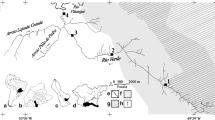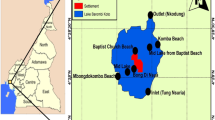Abstract
The Hun River is a major tributary of the Liao River in the northeast area of China and provides drinking water for 23 million local residents. This study was designed to assess the severity of metal contamination in the Hun River and the potential use of indigenous organisms (the fish Zacco platypus and the snail Radix swinhoei) as biomonitors of metal contamination. Water, sediment, and the native fish and snails were collected at four sampling sites that differed in their physicochemical characteristics and their contamination levels. The samples were analyzed for Cd, Cr, Cu, Ni, Pb, and Zn by ICP-MS. The results showed that although the overall potential ecological risks of the metals were low at our sampling sites, Cd posed a noteworthy ecological risk. Strong correlations were obtained between Cd concentrations in the organisms and in the environment. The results indicated that Z. platypus and R. swinhoei can be useful biomonitoring species for assessing Cd contamination. Biomonitoring with the snail may be most effective when focused on the gonad/digestive tissue (because of the high metal accumulation there), but further work is needed to confirm this.

Similar content being viewed by others
References
Boshoff M, Jordaens K, Backeljau T et al (2013) Organ- and species-specific accumulation of metals in two land snail species (Gastropoda, Pulmonata). Sci Total Environ 449:470–481
Campbell PGC (2006) Cadmium - a priority pollutant. Environ Chem 3:387–388
Croteau MN, Luoma SN, Stewart AR (2005) Trophic transfer of metals along freshwater food webs: evidence of cadmium biomagnification in nature. Limnol Oceanogr 50:1511–1519
Cui J, Zang S, Zhai D, Wu B (2014) Potential ecological risk of heavy metals and metalloid in the sediments of Wuyuer River basin, Heilongjiang Province, China. Ecotoxicology 23:589–600
De Jonge M, Dreesen F, De Paepe J, Blust R, Bervoets L (2009) Do acid volatile sulfides (AVS) influence the accumulation of sediment-bound metals to benthic invertebrates under natural field conditions? Environ Sci Technol 43:4510–4516
Directive of the European Parliament and the Council of the European Union for environmental quality standards in the field of water policy (WFD). Official Journal of European Communities; 2008/105/ECC
Doust JL, Schmidt M, Doust LL (1994) Biological assessment of aquatic pollution - a review, with emphasis on plants as biomonitors. Biol Rev 69:147–186
Elder JF, Collins JJ (1991) Fresh-water mollusks as indicators of bioavailability and toxicity of metals in surface-water systems. Rev Environ Contam Toxicol 122:37–79
Fang G-C, Yang H-C (2010) Heavy metals in the river sediments of Asian countries of Taiwan, China, Japan, India, and Vietnam during 1999-2009. Environ Forensic 11:201–206
Flessas C, Couillard Y, Pinel-Alloul B, St-Cyr L, Campbell PGC (2000) Metal concentrations in two freshwater gastropods (Mollusca) in the St. Lawrence River and relationships with environmental contamination. Can J Fish Aquat Sci 57:126–137
Guo R, He X (2013) Spatial variations and ecological risk assessment of heavy metals in surface sediments on the upper reaches of Hun River, Northeast China. Environ Earth Sci 70:1083–1090
Guo W, He M, Yang Z, Lin C, Quan X, Wang H (2007) Distribution of polycyclic aromatic hydrocarbons in water, suspended particulate matter and sediment from Daliao River watershed, China. Chemosphere 68:93–104
Hakanson L (1980) An ecological risk index for aquatic pollution control—A sedimentological approach. Water Res 14:975–1001
He Y, Meng W, Xu J, Zhang Y, Liu SS, Guo CS (2015) Spatial distribution and toxicity assessment of heavy metals in sediments of Liaohe River, northeast China. Environ Sci Pollut Res 22:14960–14970
Howell DC (1997) Statistical methods for psychology, 4th edn. Wadsworth, Belmont, CA
Huang YL, Zhu WB, Le MH, Lu XX (2012) Temporal and spatial variations of heavy metals in urban riverine sediment: an example of Shenzhen River, Pearl River Delta, China. Quat Int 282:145–151
Kalman J, Turner A (2007) An evaluation of metal bioaccessibility in estuarine sediments using the commercially available protein, bovine serum albumin. Mar Chem 107:486–497
Kalra YP, Maynard DG (1991) Methods manual for forest soil and plant analysis. Forestry Canada, Northwest Region, Northern Forestry Centre, Edmonton, Alberta. Information Report NOR-X-319
Langston WJ, Spence SK (1995) Biological factors involved in metal concentrations observed in aquatic organisms. In: Tessier A, Turner DR (eds) Metal speciation and bioavailability in aquatic systems. Vol, 3, Chap, vol 9. Johy Wiley & Sons, Toronto, pp 407–478
Lavoie RA, Jardine TD, Chumchal MM, Kidd KA, Campbell LM (2013) Biomagnification of mercury in aquatic food webs: a worldwide meta-analysis. Environ Sci Technol 47:13385–13394
Lee S, Kim C, Kim J et al (2015) Cloning metallothionein gene in Zacco platypus and its potential as an exposure biomarker against cadmium. Environ Monit Assess 187:447
Li B, Hu X, Liu R, Zeng P, Song Y (2015) Occurrence and distribution of phthalic acid esters and phenols in Hun River watersheds. Environ Earth Sci 73:5095–5106
Lin C, He M, Liu X, Guo W, Liu S (2013) Contamination and ecological risk assessment of toxic trace elements in the Xi River, an urban river of Shenyang city, China. Environ Monit Assess 185:4321–4332
Liu MX, Yang YY, Yun XY, Zhang MM, Li QX, Wang J (2014) Distribution and ecological assessment of heavy metals in surface sediments of the East Lake, China. Ecotoxicology 23:92–101
Luszczek-Trojnar E, Drag-Kozak E, Popek W (2013) Lead accumulation and elimination in tissues of Prussian carp, Carassius gibelio (Bloch, 1782), after long-term dietary exposure, and depuration periods. Environ Sci Pollut Res 20:3122–3132
MacDonald DD, Ingersoll CG, Berger TA (2000) Development and evaluation of consensus-based sediment quality guidelines for freshwater ecosystems. Arch Environ Contam Toxicol 39:20–31
Mayer LM, Schick LL, Self RFL, Jumars PA, Findlay RH, Chen Z, Sampson S (1997) Digestive environments of benthic macroinvertebrate guts: enzymes, surfactants and dissolved organic matter. J Mar Res 55:785–812
McGeer JC, Henningsen G, Lanno R, Fisher N, Sappington K, Drexler J (2004) Issue paper on the bioavailability and bioaccumulation of metals. US Environmental Protection Agency risk assessment forum, p 126
Niu HY, Deng WJ, Wu QH, Chen XG (2009) Potential toxic risk of heavy metals from sediment of the Pearl River in South China. J Environ Sci - China 21:1053–1058
Pan K, Wang W-X (2012) Trace metal contamination in estuarine and coastal environments in China. Sci Total Environ 421:3–16
Rainbow PS, Phillips DJH (1993) Cosmopolitan biomonitors of trace-metals. Mar Pollut Bull 26:593–601
SEPA of China (2004) Tenth-five-year plan of water pollution prevention and control for “three rivers and three lakes”, first edn. Chemical Industry Publishing Company, Beijing
Shi G, Chen Z, Bi C, Li Y, Teng J, Wang L, Xu S (2010) Comprehensive assessment of toxic metals in urban and sub-urban street deposited sediments (SDSs) in the biggest metropolitan area of China. Environ Pollut 158:694–703
Simpson SL, Yverneau H, Cremazy A, Jarolimek CV, Price HL, Jolley DF (2012) DGT-induced copper flux predicts bioaccumulation and toxicity to bivalves in sediments with varying properties. Environ Sci Technol 46:9038–9046
Soares H, Boaventura RAR, Machado A, da Silva J (1999) Sediments as monitors of heavy metal contamination in the Ave river basin (Portugal): multivariate analysis of data. Environ Pollut 105:311–323
Sun W, Sang L, Jiang B (2012) Trace metals in sediments and aquatic plants from the Xiangjiang River, China. J. Soils Sediments 12:1649–1657
Tan Q-G, Ke C, Wang W-X (2013) Rapid assessments of metal bioavailability in marine sediments using coelomic fluid of sipunculan worms. Environ Sci Technol 47:7499–7505
Taylor A, Maher W (2006) The use of two marine gastropods, Austrocochlea constricta and Bembicium auratum, as biomonitors of zinc, cadmium, and copper exposure: effect of tissue distribution, gender, reproductive state, and temporal variation. J Coastal Res 22:298–306
Wang R, Xu T, Yu L, Zhu J, Li X (2013) Effects of land use types on surface water quality across an anthropogenic disturbance gradient in the upper reach of the Hun River, Northeast China. Environ Monit Assess 185:4141–4151
Yap CK, Ismail A, Tan SG, Ismail AR (2004) Assessment of different soft tissues of the green-lipped mussel Perna viridis (Linnaeus) as biomonitoring agents of Pb: field and laboratory studies. Water Air Soil Pollut 153:253–268
Yap CK, Noorhaidah A, Azlan A et al (2009) Telescopium telescopium as potential biomonitors of Cu, Zn, and Pb for the tropical intertidal area. Ecotoxicol Environ Saf 72:496–506
Yap CK, Noorhaidah A, Tan SG (2012) Digestive cecum and tissue redistribution in gills of telescopium telescopium as indicators of Ni bioavailabilities and contamination in tropical intertidal areas. Water Air Soil Pollut 223:2891–2905
Yi Y, Yang Z, Zhang S (2011) Ecological risk assessment of heavy metals in sediment and human health risk assessment of heavy metals in fishes in the middle and lower reaches of the Yangtze River basin. Environ Pollut 159:2575–2585
Zhang C, Yu ZG, Zeng GM et al (2014) Effects of sediment geochemical properties on heavy metal bioavailability. Environ Int 73:270–281
Zhang JQ, Wang Z, Song ZY, Xie ZC, Li L, Song LR (2012) Bioaccumulation of microcystins in two freshwater gastropods from a cyanobacteria-bloom plateau lake, Lake Dianchi. Environ Pollut 164:227–234
Zheng B, Liu R, Liu Y, Jin F, An L (2015) Phenolic endocrine-disrupting chemicals and intersex in wild crucian carp from Hun River, China. Chemosphere 120:743–749
Zhong H, Wang WX (2006a) Metal-solid interactions controlling the bioavailability of mercury from sediments to clams and sipunculans. Environ Sci Technol 40:3794–3799
Zhong H, Wang W-X (2006b) Sediment-bound inorganic Hg extraction mechanisms in the gut fluids of marine deposit feeders. Environ Sci Technol 40:6181–6186
Zhong H, Wang W-X (2008) Methylmercury extraction from artificial sediments by the gut juice of the sipunculan, Sipunculus nudus. Environ Toxicol Chem 27:138–145
Zhou Q, Zhang J, Fu J, Shi J, Jiang G (2008) Biomonitoring: an appealing tool for assessment of metal pollution in the aquatic ecosystem. Anal Chim Acta 606:135–150
Zhu QQ, Wang ZL (2012) Distribution characteristics and source analysis of heavy metals in sediments of the main river systems in China. Earth Environ 40:305–313 (In Chinese)
Acknowledgments
This research was supported by the National Nature Science Foundation of China (NSFC, 41303087; NSFC, 31270549) and the One-hundred Talent Program of the Chinese Academy of Sciences (Y2SBR111SS).
Author information
Authors and Affiliations
Corresponding authors
Ethics declarations
Conflict of interest
The authors declare that they have no competing interests.
Human and animal rights
All applicable international, national, and/or institutional guidelines for the care and use of animals were followed.
Additional information
Responsible editor: Philippe Garrigues
Xing Wu and Shaofeng Wang contributed equally to this study and share first authorship.
Electronic supplementary material
ESM 1
(DOCX 211 kb)
Rights and permissions
About this article
Cite this article
Wu, X., Wang, S., Chen, H. et al. Assessment of metal contamination in the Hun River, China, and evaluation of the fish Zacco platypus and the snail Radix swinhoei as potential biomonitors. Environ Sci Pollut Res 24, 6512–6522 (2017). https://doi.org/10.1007/s11356-016-8348-8
Received:
Accepted:
Published:
Issue Date:
DOI: https://doi.org/10.1007/s11356-016-8348-8




